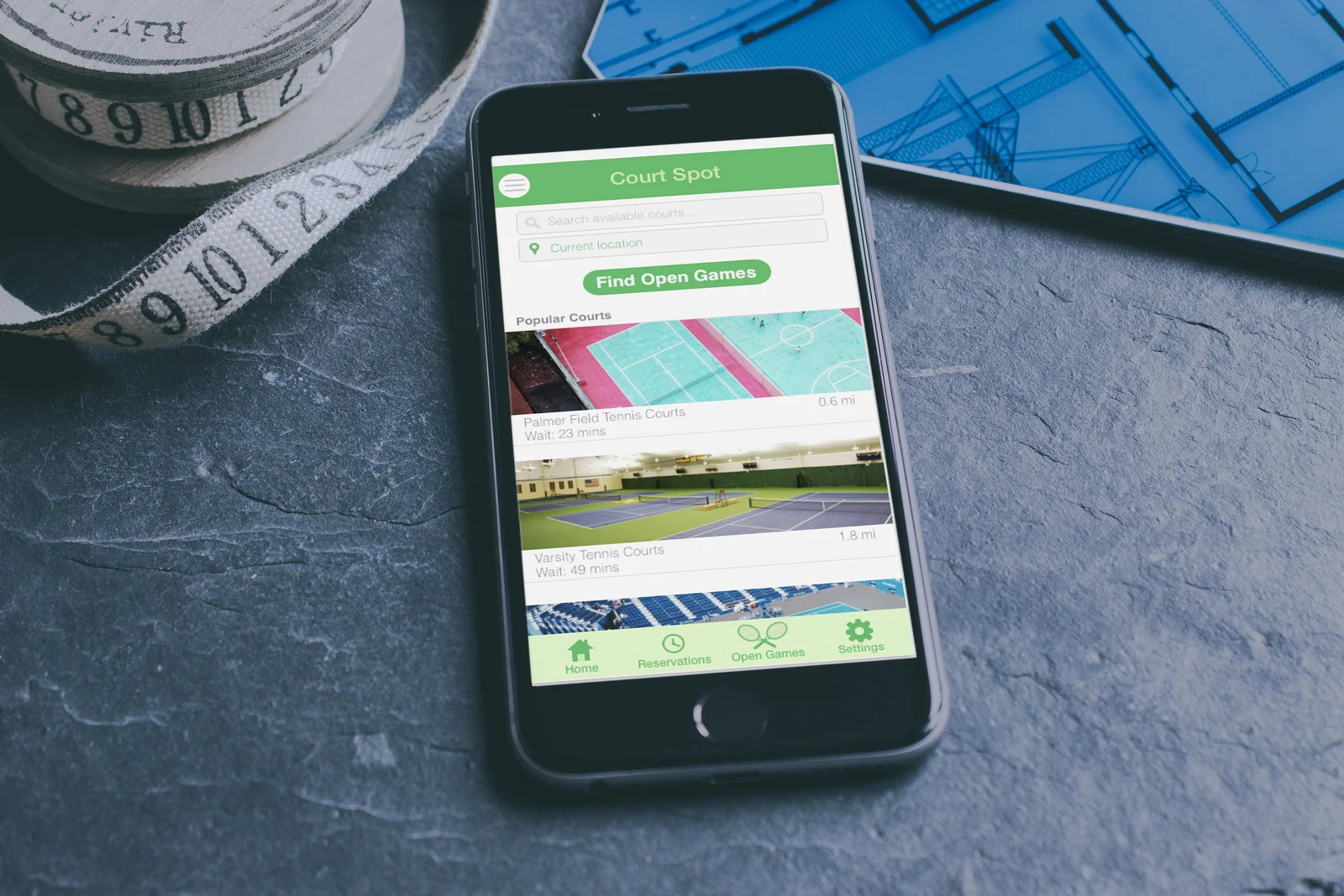Court App | UX Design
My Role
UX Designer, UX Researcher
My Responsibilities
Iterative Design, Prototyping (low to high-fidelity), User Testing
Tools
Sketch, InVision, InDesign, Pen & Paper
I designed a mobile application to help tennis players find and reserve open tennis courts as well as connect with others in need of more players. My process began with opportunity identification and ended with a high-fidelity prototype of the app in Sketch/InVision.
Check out the prototype!
The Problem
My personal experience and initial research with other tennis players showed that:
- tennis players cannot view the availability of courts before arriving at the courts and must spend time waiting for a court to open
- once at the courts, players cannot easily find out how long it will be until a court opens without asking players on each court
- new players often struggle to find other players to play with.
MY DESIGN PROCESS
1. Competitive Analysis | 2. User Research | 3. Ideation | 4. Personas | 5. Paper Prototyping | 6. User Testing | 7. Digital Prototyping
Competitive Analysis
I completed a competitive analysis to:
- Categorize competitors: direct, partial, indirect, parallel, analogous
- Discover my solution’s differentiators
- Identify target markets: advertising campaigns, branding, positioning
- Highlight competitor strengths and weaknesses
- Compile a “bug list” to convert competitor weaknesses into opportunities
User Research
As the researcher and designer on this project, I knew that I was not designing a solution for myself. While initial user research was not required for the course, I knew a thorough understanding of the context, users' needs, and users' motivations would be invaluable.
Participants:
I spoke to 7 tennis players who:
- Consistently played tennis at public tennis courts
- Varied in playing skill
- Varied in experience playing tennis
- Were looking to find new hitting partners
- Participants were engaged while they were waiting for a court to open at the Palmer Field Tennis Courts on the University of Michigan’s campus
Interviews
The goals of the early-stage research were to:
- Verify or update my initial problem statement
- Identify the needs of tennis players playing at public courts
- Identify difficulties players experience when at public courts
The interviews were conducted as 1-on-1 sessions that lasted for 20-30 minutes. Interviews were held at the Palmer Field Tennis Courts.
Findings
Synthesis of the qualitative research yielded these conclusions:
- Waiting players cannot easily find out how which court will open up next and when that court will become available
- Less experienced players struggle to find hitting partners and feel asking strangers to play is uncomfortable and intimidating
Ideation
Using discoveries from initial user research, I brainstormed solutions that would address user needs and help users meet their goals as tennis players.
Then, I sketched narrated storyboards to explore potential users, their motivations, and ways they could utilize the solutions.
Personas
Using this process, I developed 3 personas:
- Primary: The Competitor
- Secondary: The Loner Enthusiast
- Secondary: The Newbie
I also constructed a negative persona to confirm characteristics about users my product would not be targeting.
To construct personas, I:
- summarized findings from initial user research
- graphed observed behaviors and characteristics like 'tennis experience' and competitiveness on relative scales
- clustered similar characteristics to form believable personas that, together, adequately represented the users I interviewed
Story Mapping
To visualize the necessary components and features of my design, I used key persona goals and needs to develop user activities.
Paper Prototype
I used hand-drawn sketches to plan out the design, prioritize elements, and visualize the product's aesthetic. I conducted informal interviews and usability testing to iterate the paper prototype.
Reserving a court
Finding an open game
Digital Prototype
Usability testing, Sketch, and InVision brought the solution to life.
Check it out here! -->
Reserving a court
Home Page
- Search court name or view nearby
- Switch to Map view
- Select time and duration
- View availability by court
- Choose court and time
- Confirm reservation
- Toggle switch if you need players
- Customize players settings
- Invite friends
Joining an Open Game
- Select your tennis skill level
- View open games
- Switch to Map view
- View game details
- Message the game's players
- View confirmation
- Message the game's players
Reflection
What would I do differently?
- Conduct full-fledged Usability Testing:
where it stands now, the app needs fine tuning and should be put through its paces with real users - Remember to incorporate iOS guidelines early:
remembering to follow industry design guidelines late in the process caused some need for revision
What did I learn?
- Stay low-fidelity for as long as possible:
this is where user needs are met, where the usability of core features is exposed - Design without Research is just self-indulgence:
early interviews with users uncovered insights that ultimately led to core features































